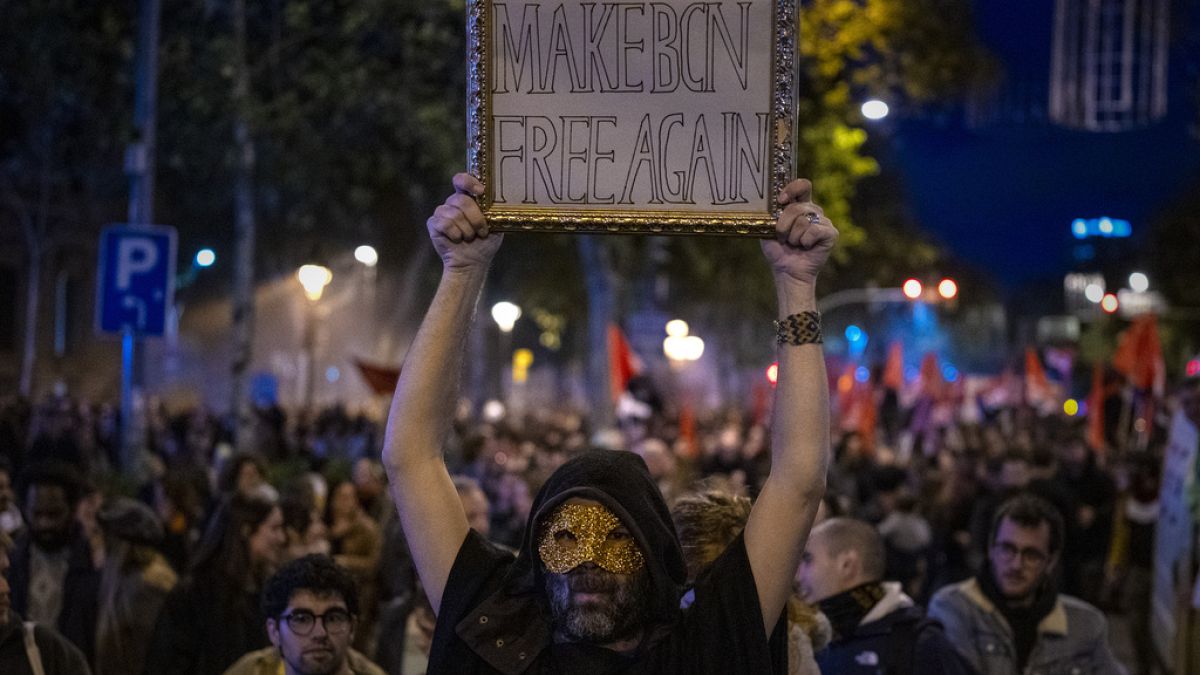Trump’s trading cards won’t save NFTs from the digital graveyard

Less than two years after the NFT market crashed, Donald Trump is still hawking his bizarre trading cards. Aside from entertaining his rabid fans, what is left of the NFT market?
Last month, ex-US president Donald Trump announced he was selling a new collection of his digital trading cards. The cards, announced in typical Trump style on his Truth Social platform, cost $99 (€90) each and if you buy 15 or more, you will receive an actual physical card with a piece of the suit he wore to his debate with Joe Biden.
It’s not the first time Trump has flogged these cards.
The original 2022 collection sold out in a matter of hours with sales totalling a hefty $4.5 million (€4.1 million). Nor is it the first sales gambit the 2024 presidential candidate has subjected his loyal supporters to.
Earlier this year, Trump promoted the $60 ‘God Bless the U.S.A. Bible’, purportedly the only King James bible to be endorsed by the one-time president. He’s also used the highly publicised mugshot of him at Fulton County Jail to sell coffee mugs, T-shirts, and more of his trading cards.
Plainly, these are money-making tactics for a disgraced presidential hopeful that is potentially more skint than his bravado billionaire persona would allow.
However, while the promise of a collection of non-fungible token (NFT) collectors cards might have made sense as a value proposition in 2022, although they have sold out, it’s not clear if the latest collection has sold out with the same immediacy of his prior attempt.
Trump might boast that “they call me the crypto-president,” but while NFTs were an unrelenting cornerstone of popular conversation as cryptocurrency took over every finance bro’s entire personality in 2022, two years later the subject has been quietly dropped.
“NFTs had their boom and bust in 2022 when people were stuck at home during Covid,” Dr John Hawkins, a senior lecturer at the Canberra School of Politics, Economics & Society at the University of Canberra tells Euronews Culture.
“Their value has not recovered,” Hawkins adds. When looking at the “market capitalisation” of all NFTs, the peak value was nearing the trillions of dollars during 2022. It’s comparatively near zero now.
The NFT market’s bull run from 2021-2022 peaked in August 2021 when one week’s trading reached $3.24 billion (€2.96 billion). According to data from the Block, the most recent week on record, from 29 September to 6 October, recorded just $67.93 million (€62.03 million) in trading. That’s just over 2% of the figure from three years ago.
Take the most popular example of the NFT, the Bored Ape that was promoted by stars as varied as Eminem, Post Malone, Madonna, and Paris Hilton, and sales have dropped exactly in line with the general pattern.
At the time, the Bored Ape NFTs were promoted as intriguing investments in digital art that would potentially prove incredibly lucrative. Touted by stars who could afford to make the occasional unsuccessful investment, those same stars quickly went quiet about their sparkly new NFTs.
It’s the rest of the public, lured in by the promise of easy riches, that have caused these NFTs to drop so precipitously. With Bored Apes and other NFTs’ value crashing, the little hope of being saved has been crushed by now-cautious buyers.
“There are a lot of buyers that were burnt the first time who may be very reluctant to try again,” Hawkins explains. “Bitcoin’s price has recovered from previous crashes, so it is not impossible I guess.”
Bitcoin and other major cryptocurrencies have had massive market fluctuations, but as Bitcoin continues to rocket to increasingly eye-watering values – and likely make some techbros very rich – it’s yet to be seen if that trend will be replicated with NFTs.
Last year, dappGambl, a crypto gambling expertise site, ran research stating that 95% of all NFTs are now worthless investments. It’s not just that so many are worthless, but it’s rare that they’re even being bought anymore – 79% remain unsold.
Why haven’t NFTs had the same longevity that cryptocurrencies like Bitcoin have had? It likely comes down to the same criticism they received during their brief zeitgeist. Whereas Bitcoin has a functional use-case as a currency alternative, NFTs were ultimately ways for venal people to show off their ownership of digital images.
Digital images are, naturally, easily replicated and shared. The kudos in owning the “original” is completely hollow. Its value is inherent only in the value you put into the kudos of owning it. There’s a reason that sounds circular. It is.
While some (questionably) interesting artists put out NFT artworks – such as Damien Hirst’s controversial work ‘The Currency’ – for the most part NFTs were unartistic juvenile graphics invested in by people hoping that it would function as a get rich quick scheme.
Bitcoin’s rise is due to market belief it would become a legitimate market tool. NFTs are just art trading for people who don’t recognise the value of either art or the indivisibility of canvas.
This is all to say, Trump’s latest desperate cash grab business is unlikely to presage a bounceback for NFTs. However, that doesn’t mean they won’t be financially lucrative for him, says Hawkins.
“The Trump cards are different in that they are being promoted by someone with a huge fan base and media access,” he explains. On the other hand, “ultimately they are a speculative asset with no underlying value that generates no cash flow.”
Trump does have one hope though. There is a discrete event that will be a huge driver of their price.
“If Trump wins, the chances of their price going up is enormously higher than if he loses,” Hawkins says. “It’s a bit like the value of his Truth Social.”
World News || Latest News || U.S. News
Source link



